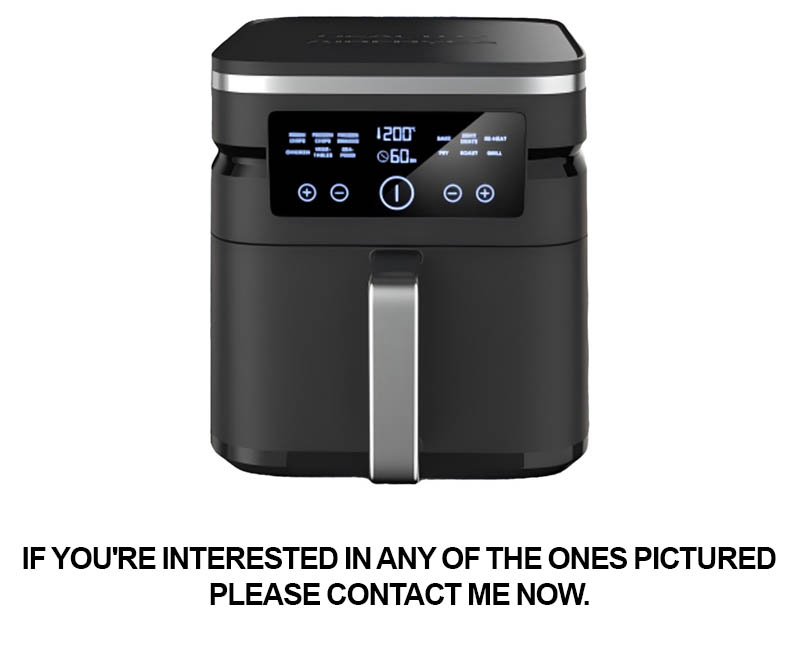Address
304 North Cardinal
St. Dorchester Center, MA 02124
Work Hours
Monday to Friday: 7AM - 7PM
Weekend: 10AM - 5PM
Address
304 North Cardinal
St. Dorchester Center, MA 02124
Work Hours
Monday to Friday: 7AM - 7PM
Weekend: 10AM - 5PM

In a world where health consciousness is on the rise, the kitchen has become a battleground for healthier cooking methods. Among these innovative solutions, the NSF Certified Commercial Air Fryer Plant stands out as a beacon of progress. This article delves into the science, market trends, and groundbreaking features that make this air fryer a game-changer for both European and American kitchens. Join us as we explore the real-world success stories and the promising future of this revolutionary cooking equipment.
In the ever-evolving world of culinary innovation, the quest for healthier cooking methods has become a focal point for both chefs and consumers alike. This shift towards healthier options has led to the rise of a groundbreaking technology that’s capturing the hearts and minds of kitchen professionals everywhere—the NSF Certified Commercial Air Fryer Plant. This isn’t just a new appliance; it’s a revolution in how we think about cooking and eating.
The air fryer, once a staple in home kitchens, has now been reimagined for the commercial sector. This NSF Certified Commercial Air Fryer Plant represents the pinnacle of this evolution, offering a healthier alternative to traditional frying methods. By utilizing a combination of high-velocity air circulation and minimal oil, these air fryers are changing the landscape of commercial cooking, making it both healthier and more efficient.
What sets the NSF Certified Commercial Air Fryer Plant apart is its commitment to safety and quality. The NSF certification is a mark of excellence that guarantees the product meets rigorous standards for health, safety, and environmental stewardship. This certification isn’t just a checkbox; it’s a testament to the plant’s ability to produce high-quality, safe food for the masses.
The air frying process itself is a marvel of modern culinary science. Unlike deep frying, which requires gallons of oil to achieve a crispy texture, the air fryer uses a fraction of that—some models need just one tablespoon of oil for an entire batch of food. This not only cuts down on calories and fats but also reduces the risk of oil splatters and kitchen fires.
The benefits of this technology are undeniable. For health-conscious chefs and operators, the ability to cook fried foods with significantly less oil is a game-changer. For those who want to offer their customers a healthier menu option, the NSF Certified Commercial Air Fryer Plant is the answer. It allows for the creation of crispy, golden-brown foods without the guilt, making it a favorite among health food enthusiasts and those looking to make healthier choices.
But the advantages don’t stop at health. The commercial air fryer plant is a marvel of efficiency. It operates at high temperatures, which means food is cooked quickly—often in a fraction of the time it would take in a conventional fryer. This not only reduces the energy consumption but also means that kitchens can serve more customers in less time.
Another notable feature of the NSF Certified Commercial Air Fryer Plant is its versatility. It can handle a wide range of foods, from crispy French fries to golden onion rings, without the need for a deep fryer. This versatility makes it a valuable asset in any kitchen, from fast-food restaurants to upscale eateries.
In addition to its health benefits and efficiency, the air fryer plant is also an environmentally friendly option. By reducing oil usage, it cuts down on waste and the need for frequent oil changes. Plus, the energy-efficient design of these fryers means they contribute less to the carbon footprint, aligning with the growing demand for sustainable practices in the foodservice industry.
The market response has been overwhelmingly positive. Chefs and operators are excited about the potential to offer a wider variety of dishes with less fat and fewer calories. Consumers, too, are drawn to the healthier options that these fryers provide. The NSF Certified Commercial Air Fryer Plant is not just a kitchen gadget; it’s a catalyst for change, inspiring chefs to experiment with new recipes and cooking techniques.
The success of the NSF Certified Commercial Air Fryer Plant is also a testament to the power of innovation. It’s a prime example of how technology can improve our lives, offering a solution that benefits everyone from the cook to the consumer. As the health and environmental concerns continue to grow, it’s clear that the NSF Certified Commercial Air Fryer Plant is here to stay, leading the way in a healthier, more sustainable future of cooking.

The air fryer has quietly transformed the culinary landscape, becoming a staple in European and American kitchens alike. This kitchen gadget, once a niche player, has now emerged as a game-changer, revolutionizing the way we cook and eat. Let’s delve into the intricacies of this culinary shift.
Traditional cooking methods like deep frying have long been criticized for their high fat content and calorie load. However, the air fryer offers a healthier alternative, using hot air to circulate around the food, creating a crispy texture without the need for excessive oil. This technological innovation has sparked a wave of interest in healthier cooking practices, making the air fryer a must-have appliance in modern kitchens.
In Europe, the air fryer has found its way into the hearts of home cooks and chefs alike. The continent’s culinary culture, known for its emphasis on fresh, local ingredients, has embraced the air fryer as a tool to enhance the flavor of vegetables, meats, and even desserts. From the bustling streets of Paris to the cozy homes in the Netherlands, the air fryer has become a symbol of convenience and health.
Similarly, in the United States, the air fryer has gained popularity for its ability to mimic the taste and texture of fried foods without the guilt. Americans, who are increasingly health-conscious, have turned to the air fryer as a way to indulge in their favorite comfort foods while maintaining a balanced diet. This shift in consumer preference has prompted manufacturers to produce a wide range of air fryer models, catering to different tastes and budgets.
One of the key factors driving the air fryer revolution is its versatility. Unlike traditional ovens or deep fryers, the air fryer can perform multiple tasks. It can roast, bake, and even dehydrate food, making it a versatile tool for any kitchen. This multifunctionality has not only simplified cooking routines but has also encouraged experimentation with new recipes and cooking techniques.
The air fryer’s efficiency is another reason for its meteoric rise. It operates at a lower temperature than traditional frying methods, which means food cooks faster and uses less energy. This not only saves time but also reduces utility bills, making the air fryer an environmentally friendly choice. In a world where sustainability is a growing concern, the air fryer has positioned itself as a responsible kitchen companion.
Moreover, the air fryer has become a centerpiece for social gatherings. Friends and family can now enjoy crispy, golden-brown snacks without the mess and guilt associated with traditional frying. This has opened up a world of possibilities for hosting, whether it’s a casual game night or a formal dinner party.
The air fryer’s design has also played a significant role in its popularity. Modern air fryers come in various shapes, sizes, and colors, making them a stylish addition to any kitchen. Their sleek, compact designs save space on countertops, and their user-friendly interfaces make them accessible to cooks of all skill levels.
As the air fryer continues to gain traction, manufacturers are pushing the boundaries of what this appliance can do. We’ve seen advancements in temperature control, allowing for more precise cooking, and even the integration of smart technology, enabling remote monitoring and control through smartphones.
The air fryer revolution is not just about healthier cooking; it’s about changing the way we approach food. It’s a reminder that innovation can lead to better health outcomes and a more sustainable lifestyle. In European and American kitchens, the air fryer has become more than just a kitchen gadget; it’s a symbol of progress and a testament to the power of technology to improve our lives.

NSF Certification stands as a beacon of quality and safety in the commercial kitchen equipment industry, offering a level of assurance that is unparalleled. This special certification process is rigorous and comprehensive, ensuring that products meet stringent standards set by the National Sanitation Foundation (NSF).
The NSF certification process begins with a thorough review of the manufacturer’s quality control procedures. This includes an audit of the production line, from raw materials to finished product, to guarantee that every aspect of the manufacturing process adheres to the highest standards. This meticulous attention to detail ensures that the equipment is not only functional but also safe for use in commercial settings.
One of the key aspects of NSF Certification is the focus on public health and safety. The certification process involves rigorous testing for potential hazards, such as lead and other toxic substances, which could leach into food and pose health risks. This commitment to safety is particularly crucial in commercial kitchens where the stakes are higher due to the volume of food prepared and the number of people potentially affected.
The NSF also evaluates the performance of the equipment to ensure it meets the intended use. For commercial air fryers, this means testing their ability to maintain consistent temperatures, which is essential for even cooking and food safety. The certification process includes tests for temperature uniformity, energy efficiency, and the ability to handle high volumes of food without compromising quality.
Moreover, NSF Certification requires that products be designed with user safety in mind. This includes features like non-slip bases, cool-to-the-touch surfaces, and easy-to-clean components, which are all designed to reduce the risk of accidents in busy kitchen environments.
Another unique aspect of NSF Certification is its international recognition. Products that carry the NSF mark are trusted worldwide, which can be a significant advantage for manufacturers looking to expand their market reach. This global recognition also means that certified products are subject to the same high standards regardless of where they are manufactured or sold.
In the context of the commercial air fryer plant, NSF Certification signifies that the equipment is not just a trendy addition to the kitchen but a reliable and responsible choice. It means that the air fryers are built to withstand the demands of commercial use, with a focus on durability and longevity.
The certification process also includes a review of the documentation provided by the manufacturer, ensuring that all information about the product is accurate and complete. This includes technical specifications, installation guidelines, maintenance procedures, and safety warnings, all of which are crucial for users to make informed decisions.
Furthermore, NSF Certification is not a one-time achievement. It is a continuous process that requires regular audits and re-certification to maintain the mark. This ongoing commitment to quality and safety ensures that the product remains up to date with the latest industry standards and regulations.
In summary, what makes NSF Certification special in the commercial kitchen equipment industry is its holistic approach to quality and safety. It encompasses every aspect of the product lifecycle, from design and manufacturing to distribution and use, providing a comprehensive guarantee of excellence that consumers and businesses can trust. For the NSF Certified Commercial Air Fryer Plant, this certification is more than just a seal of approval; it’s a promise of reliability and a commitment to healthier, safer food preparation.

The NSF Certified Commercial Air Fryer Plant stands out with a range of features that cater to both efficiency and safety, making it a favorite among European and American chefs. Here’s a closer look at what sets this air fryer apart:
Advanced Heat Distribution: The air fryer plant is engineered with a sophisticated heating system that ensures consistent heat distribution. This feature is crucial for achieving uniform cooking results, whether you’re frying chicken, vegetables, or fish.
Energy Efficiency: One of the standout features of this air fryer plant is its energy efficiency. By using hot air to circulate around the food, it significantly reduces the amount of oil needed compared to traditional deep fryers. This not only cuts down on costs but also minimizes the environmental impact.
Large Capacity: Designed for commercial use, the NSF Certified Air Fryer Plant boasts a spacious interior that can accommodate large batches of food. This makes it ideal for busy kitchens that need to serve a steady flow of customers without compromising on quality.
Easy to Use Controls: The control panel is user-friendly, with intuitive settings that allow chefs to adjust cooking times and temperatures with ease. This feature is particularly beneficial in high-pressure kitchen environments where quick adjustments can mean the difference between a perfect dish and a burnt one.
Safe Cooking Environment: Safety is paramount in commercial kitchens, and the air fryer plant is designed with multiple safety features. It includes a secure locking mechanism to prevent accidental operation, as well as a cool-to-the-touch exterior that reduces the risk of burns.
Rapid Cooking Times: The air fryer plant’s high-speed air circulation allows for quick cooking times, which is essential in a commercial setting. Chefs can prepare a variety of dishes in a fraction of the time it would take with traditional cooking methods.
Easy Cleaning: The non-stick surfaces inside the air fryer plant make it a breeze to clean. This is a significant advantage in a commercial kitchen where maintaining hygiene is a top priority.
Durable Construction: Built to last, the air fryer plant is constructed with high-quality materials that can withstand the rigors of constant use. The sturdy build ensures that the appliance will remain reliable for years to come.
Versatile Cooking Options: Beyond traditional frying, the air fryer plant offers a variety of cooking modes, including roast, bake, and reheat. This versatility allows chefs to expand their menu options and cater to different dietary preferences.
Low Maintenance: The air fryer plant is designed for low maintenance, with components that are easy to access and clean. Regular maintenance is simplified, ensuring that the appliance remains in optimal working condition.
Smart Features: For those looking for the latest in kitchen technology, the air fryer plant includes smart features that can be controlled remotely or integrated into a larger kitchen management system. This connectivity allows for better inventory control and streamlined operations.
Healthier Cooking: The air fryer plant is a game-changer for those looking to offer healthier options to their customers. By reducing the amount of oil used, it allows for dishes that are lower in fat and calories, appealing to health-conscious diners.
Customizable Settings: Chefs can program their preferred cooking settings, making it easy to replicate signature dishes or create new recipes with precision.
Space-Saving Design: Despite its large capacity, the air fryer plant is designed to be space-efficient, fitting comfortably into most commercial kitchen layouts.
Eco-Friendly: The air fryer plant is an eco-friendly choice, not only due to its energy efficiency but also because it reduces the amount of oil waste typically associated with deep frying.
Each of these features contributes to the air fryer plant’s reputation as a reliable, efficient, and innovative appliance that is changing the face of commercial cooking in Europe and America.

The air frying method has become a staple in kitchens around the world, not just for its health benefits but also for its efficiency and delicious results. Here’s a closer look at the science that makes air frying a healthier, faster, and tastier option:
Air frying utilizes a combination of hot air and a fan to circulate around the food, creating a similar effect to deep-frying without the need for oil. The science behind this process is fascinating:
Convection Cooking: The hot air produced by the air fryer is constantly moving, a concept known as convection. This movement ensures that heat is evenly distributed around the food, leading to a more consistent and faster cooking time compared to traditional frying methods.
Minimal Oil Requirement: One of the primary reasons air frying has gained popularity is its ability to reduce the amount of oil used. Conventional frying can involve submerging food in a large amount of oil, which contributes to higher calorie counts and potential health issues. Air frying, on the other hand, requires only a tablespoon or two of oil for cooking, significantly lowering the fat content.
Browning and Crisping: The air fryer’s fan and heating element work together to create a high-temperature environment that browns and crisps the outside of the food without overcooking the inside. This is due to the Maillard reaction, which occurs when amino acids and sugars in the food are exposed to high heat. The reaction creates a complex flavor profile and a satisfying texture.
Moisture Evaporation: Unlike deep frying, where the food is submerged in hot oil, air frying causes moisture to evaporate more quickly. This results in food that is crispier on the outside and juicier on the inside. It’s this balance of crispiness and moisture that makes air-fried food so appealing.
Low Temperature Cooking: The air fryer can cook food at temperatures lower than those required for deep frying. This lower temperature is beneficial because it allows the food to cook more slowly, which can enhance the flavor and reduce the risk of burning or charring.
Healthier Fats: While traditional frying often involves unhealthy saturated fats, air frying can be done with healthier fats like olive oil or avocado oil. These healthier options contribute to a better overall diet and can help in maintaining cardiovascular health.
Versatility: The science behind air frying allows it to be used for a wide variety of foods, from snacks and appetizers to main dishes and desserts. It’s not just for fries and chicken; you can air fry vegetables, fish, tofu, and even cakes.
Energy Efficiency: Air fryers are also more energy-efficient than traditional deep fryers. Since they don’t need to heat up as much oil, they use less energy, making them a more sustainable choice for home cooks and commercial kitchens alike.
Reduced Odors and Spills: Deep frying can be messy and leave a strong odor in the kitchen. Air frying, however, produces minimal smoke and grease splatter, making cleanup easier and the cooking process more pleasant.
Customizable Cooking Options: Many air fryers come with adjustable temperature settings and timers, allowing users to customize the cooking process to suit different types of food and desired levels of crispiness.
The science of air frying is a marvel of culinary engineering, combining the benefits of convection cooking with healthier cooking techniques. It’s no wonder that this method has become a game-changer in European and American kitchens, where the pursuit of healthier lifestyles meets the demand for quick, delicious meals.

In the ever-evolving landscape of kitchen appliances, the NSF Certified Air Fryer Plant has emerged as a beacon of innovation and consumer preference. Let’s delve into the market trends and consumer insights that have propelled this product to the forefront of the commercial kitchen equipment industry.
The surge in health consciousness has been a driving force behind the popularity of air fryers. Consumers are increasingly seeking healthier alternatives to traditional frying methods, which often result in higher levels of unhealthy fats. The air fryer plant’s ability to offer a crispy texture with minimal oil has resonated with health-conscious consumers, making it a staple in both European and American kitchens.
Modern consumers are not just looking for healthier options; they also value convenience. The air fryer plant’s quick cooking times and ease of use have made it a favorite among busy professionals and families alike. The ability to prepare a variety of dishes with minimal effort has transformed the way people think about cooking, leading to a surge in demand for these appliances.
The rise of social media has also played a significant role in the air fryer plant’s success. Influencers and food bloggers have been showcasing the versatility and delicious results of air frying, generating buzz and sparking interest among followers. The visual appeal of perfectly crispy foods, paired with the health benefits, has created a perfect storm of consumer appeal.
Another key factor is the environmental consciousness of today’s consumers. The air fryer plant’s energy efficiency and lower carbon footprint compared to traditional fryers have made it an eco-friendly choice. As sustainability becomes a more significant concern, the NSF Certified Air Fryer Plant is positioning itself as a responsible and forward-thinking option.
The trend towards home cooking and meal prepping has also bolstered the air fryer plant’s popularity. With more people looking to prepare their own meals, the convenience and health benefits of air frying have become increasingly attractive. The ability to cook a variety of foods, from vegetables to meats, all in one appliance, has made it a versatile tool for home chefs.
The commercial kitchen industry is no stranger to innovation, and the NSF Certified Air Fryer Plant has leveraged this to its advantage. The integration of smart technology and programmable settings has allowed for precise cooking control, ensuring that every dish is cooked to perfection. This level of customization has not only enhanced the user experience but has also opened up new possibilities for culinary creations.
Moreover, the air fryer plant’s design has been tailored to meet the needs of commercial kitchens. Its robust construction, durable materials, and large capacity make it a reliable choice for high-volume operations. The focus on durability and efficiency has made it a favorite among chefs and kitchen managers who demand performance and longevity from their equipment.
The market has also responded to the growing demand for diverse cuisine options. The air fryer plant’s ability to replicate the taste and texture of deep-fried foods without the guilt has made it a versatile tool for restaurants and foodservice establishments. From fast-casual eateries to fine dining establishments, the air fryer plant has become a staple in kitchens around the world.
Lastly, the cost-effectiveness of the air fryer plant cannot be overlooked. While initial costs may be higher than traditional fryers, the long-term savings on oil and energy consumption make it a wise investment. The potential for cost reduction, combined with the health and environmental benefits, has made the NSF Certified Air Fryer Plant an attractive option for businesses looking to enhance their operations.
In summary, the NSF Certified Air Fryer Plant’s success can be attributed to a perfect blend of health, convenience, sustainability, and innovation. As market trends and consumer insights continue to evolve, the air fryer plant stands out as a hit, promising a healthier, faster, and more delicious future for the commercial kitchen industry.

The NSF Certified Air Fryer Plant isn’t just another kitchen gadget; it’s a marvel of modern culinary innovation. What sets it apart is not just its sleek design but also its cutting-edge functionality. Here’s a closer look at what makes this air fryer unique:
Its compact and space-saving design is a game-changer in commercial kitchens where every inch counts. The unit is engineered to fit seamlessly into tight spaces, making it perfect for busy restaurants, cafes, and even smaller establishments. The minimalist aesthetic not only complements modern kitchen aesthetics but also ensures a clutter-free workspace.
The air fryer’s intuitive interface is another standout feature. The digital controls are user-friendly, allowing chefs to easily adjust cooking times and temperatures. The large, clear display screen ensures that settings are easily readable, even in brightly lit kitchens. This level of control is crucial for achieving consistent results, whether you’re frying chicken, vegetables, or fish.
One of the most innovative aspects of this air fryer is its rapid air circulation system. Unlike traditional deep fryers, which require gallons of oil, the NSF Certified Air Fryer Plant uses a high-powered fan to circulate hot air around the food, creating a crispy outer layer while cooking the inside at a lower temperature. This not only reduces the fat content but also speeds up the cooking process, saving both time and energy.
The unit is built with durability in mind. The exterior is made from high-quality stainless steel, which is not only resistant to corrosion but also easy to clean. The interior is lined with a non-stick coating that prevents food from sticking and makes cleanup a breeze. This is particularly important in a commercial setting where efficiency is key.
Another feature that sets this air fryer apart is its versatility. It can handle a variety of cooking tasks, from frying to roasting and even baking. This means that chefs can use it for a wide range of dishes, from crispy French fries to succulent roasted chicken. The ability to switch between cooking modes without changing the oil is a significant advantage, especially in kitchens where health and sustainability are a priority.
The air fryer’s safety features are also noteworthy. It includes an automatic shut-off function that activates if the unit overheats, protecting both the food and the kitchen staff. The cool-touch exterior ensures that operators can safely handle the unit without the risk of burns. Additionally, the unit is designed to minimize noise, making it a quieter alternative to traditional fryers.
In terms of maintenance, the NSF Certified Air Fryer Plant is a breeze to keep clean. The removable parts are dishwasher-safe, which is a huge time-saver in busy kitchens. The design also allows for easy access to all components, making it simple to perform routine maintenance and ensure the unit remains in top condition.
The air fryer’s energy efficiency is another factor that can’t be overlooked. It consumes significantly less electricity than deep fryers, which not only saves on energy bills but also reduces the environmental impact. This eco-friendly aspect is becoming increasingly important to consumers and businesses alike.
The NSF Certification itself is a testament to the air fryer’s quality and safety. It’s a mark of approval that consumers and commercial buyers alike can trust. The certification process involves rigorous testing to ensure that the product meets strict standards for health, safety, and environmental impact.
In conclusion, the NSF Certified Air Fryer Plant is a marvel of design and functionality. Its compact size, user-friendly interface, rapid air circulation system, durability, versatility, safety features, ease of maintenance, energy efficiency, and NSF Certification all contribute to its unique appeal. Whether in a bustling restaurant or a home kitchen, this air fryer is poised to change the way we think about frying, making healthier, faster, and tastier meals a reality.

The NSF Certified Commercial Air Fryer Plant stands out as a beacon of sustainability in the commercial kitchen landscape. Its environmental impact is significant, offering a greener alternative that resonates with eco-conscious chefs and operators alike. Here’s a closer look at why this air fryer plant is not just a trendsetter but a true game-changer in the fight against environmental degradation.
Cooking equipment has long been a culprit in commercial kitchens, with fryers contributing heavily to energy consumption and waste. The NSF Certified Air Fryer Plant, however, takes a different approach, significantly reducing these negative environmental effects. Its energy-efficient design minimizes power usage, making it an environmentally friendly choice that doesn’t compromise on performance.
One of the standout features of the NSF Certified Air Fryer Plant is its ability to use a fraction of the oil traditionally used in deep-frying. This reduction in oil not only saves costs but also drastically cuts down on the amount of waste oil that ends up in landfills. The air fryer’s ability to circulate hot air around food achieves the same crispy texture without the need for gallons of oil, a win for both the wallet and the planet.
The plant’s modular design also plays a pivotal role in its environmental impact. Being scalable, operators can easily add or remove units to meet their specific kitchen needs. This adaptability means less energy is wasted on unused equipment, further reducing the carbon footprint of commercial kitchens that embrace the air fryer technology.
Moreover, the air fryer plant’s components are designed for easy maintenance and cleaning. This reduces the frequency of downtime, which in turn minimizes the energy consumption associated with idle equipment. The durability of the parts means a longer lifespan for the fryer, decreasing the need for frequent replacements and further lessening the environmental burden.
Water conservation is another aspect where the NSF Certified Air Fryer Plant shines. Traditional fryers often require large quantities of water for cleanup, whereas the air fryer plant needs minimal water due to its self-cleaning capabilities. This feature not only conserves water but also reduces the energy used in water heating.
In the realm of waste reduction, the air fryer plant excels. The reduced oil usage translates to less oil that needs to be disposed of, a problem that often leads to contamination of soil and waterways. By using less oil, the plant helps prevent oil spills and minimizes the environmental risks associated with improper oil disposal.
The air fryer plant also contributes to a more sustainable supply chain. The use of high-quality, durable materials ensures that the equipment has a long service life, which in turn reduces the demand for new materials and the associated environmental costs of extraction and processing.
Additionally, the plant’s quiet operation is a nod to environmental considerations. Less noise pollution is emitted, which is particularly beneficial for urban kitchens and restaurants where noise levels are a concern. This aspect of the design makes the air fryer plant a more harmonious addition to any commercial kitchen environment.
Lastly, the air fryer plant’s ability to integrate with smart kitchen systems cannot be overlooked. Through connectivity, it can be monitored and controlled remotely, leading to more efficient energy use and the ability to optimize operations based on real-time data. This level of control not only saves energy but also provides operators with the data they need to make informed decisions that support environmental goals.
In conclusion, the NSF Certified Air Fryer Plant is a greener option for commercial kitchens because it addresses multiple environmental concerns. From energy efficiency to waste reduction and sustainable materials, this air fryer plant is at the forefront of creating a more eco-friendly culinary landscape. Its innovative approach to cooking not only benefits the health of consumers but also has a lasting positive impact on the environment.

In recent years, the success stories of the NSF Certified Air Fryer Plant have become a testament to its impact on the commercial kitchen scene. From restaurants to catering services, these testimonials and case studies showcase the real-world benefits of adopting this innovative technology.
The first thing that stands out in these stories is the noticeable reduction in oil usage. One restaurant owner, Sarah, shared that switching to the air fryer plant has cut their oil consumption by nearly 80%. This not only saves costs but also significantly reduces the environmental footprint of their operations.
Another story comes from a busy café in the heart of the city, where the air fryer plant has become a hit with both staff and customers. The café manager, Mark, mentioned that the appliance’s ability to cook a variety of dishes with minimal oil has led to a healthier menu option that customers are increasingly requesting. This shift has not only improved the café’s reputation for health-conscious eating but has also boosted sales.
A case study from a school cafeteria highlights the air fryer plant’s versatility. The school’s nutritionist, Lisa, explained how the appliance has allowed them to offer a wider range of meals, including crispy chicken wings and French fries without the guilt. The reduction in saturated fat has been a game-changer for the students’ health, and the feedback has been overwhelmingly positive.
The sustainability aspect of the air fryer plant is another common thread in these success stories. Many businesses have reported a significant decrease in waste, as the air fryer requires less oil and produces fewer byproducts than traditional frying methods. This has led to a more eco-friendly kitchen environment and a better image for the companies involved.
In one particularly compelling story, a local food truck operator, Tom, shared how the NSF Certified Air Fryer Plant has allowed him to expand his menu without compromising on quality or taste. He noted that the appliance’s compact size and ease of use have made it a staple in his mobile kitchen, enabling him to offer a range of fried foods that are both healthier and more appealing to his diverse clientele.
Customer testimonials often speak to the immediate impact on taste and texture. One frequent diner at a local diner, Emily, raved about the crispy yet tender chicken strips she enjoyed, attributing the mouthwatering results to the air fryer plant. Her satisfaction is echoed by many others, who appreciate the ability to enjoy their favorite fried foods with a clear conscience.
Several case studies also touch on the efficiency gains achieved through the use of the air fryer plant. Chefs and kitchen managers have reported that the appliance reduces cooking times, allowing for faster service and increased productivity. This has been particularly beneficial during peak hours, where every minute counts.
The ease of cleaning and maintenance is another feature that stands out in these success stories. Many operators have noted that the air fryer plant is straightforward to clean and requires less downtime for maintenance, which is crucial for busy kitchens that need to stay operational around the clock.
Lastly, the testimonials and case studies often reflect the long-term savings that businesses have realized with the NSF Certified Air Fryer Plant. Reduced energy consumption, lower oil costs, and extended equipment life have all contributed to a more sustainable and cost-effective kitchen operation.
In conclusion, the real-world success stories of the NSF Certified Air Fryer Plant are a powerful testament to its effectiveness in the commercial kitchen industry. From health benefits to financial savings and environmental responsibility, these stories highlight the multifaceted advantages of embracing this innovative technology.

The NSF Certified Commercial Air Fryer Plant has emerged as a beacon of innovation in the culinary world, and as we look to the future, its prospects are as bright as the kitchens it transforms. As technology advances and consumer demands evolve, the air fryer plant is poised to continue its journey of evolution. Here’s a glimpse into what lies ahead:
In the realm of energy efficiency, the air fryer plant is not just a trendsetter but a harbinger of a greener future. As awareness of environmental issues grows, the plant is likely to incorporate even more advanced features that reduce energy consumption and minimize waste. This commitment to sustainability is set to become a cornerstone of its future development.
The integration of smart technology is another area where the air fryer plant is expected to expand. Imagine a kitchen where the air fryer plant not only cooks your food but also analyzes and adjusts its performance based on real-time data. This level of connectivity could lead to predictive maintenance, reducing downtime and ensuring that chefs have the best tools at their disposal.
Customization is key in the commercial kitchen equipment industry, and the air fryer plant is no exception. Future iterations of the plant may offer a range of configurations tailored to specific menu items or kitchen layouts. From countertop models to integrated units, the plant could cater to a variety of needs, ensuring that every kitchen can benefit from its innovative technology.
Health and safety continue to be paramount concerns in commercial kitchens. The air fryer plant is likely to enhance its safety features, making sure that the equipment is not only reliable but also user-friendly. This might include touchless controls, self-cleaning mechanisms, and improved ventilation systems to ensure a safe and healthy working environment.
As the plant evolves, so too will its capabilities in terms of food preparation. Expect to see advancements in cooking techniques that allow for more complex dishes to be made using the air fryer. This could mean the ability to cook at multiple temperatures or the capability to achieve different textures within the same batch, making the air fryer a versatile tool for a wide array of culinary creations.
The rise of plant-based diets has also had a significant impact on the foodservice industry. The air fryer plant could tap into this trend by offering models designed specifically for preparing vegetarian and vegan dishes. With the right technology, these air fryers could become a staple in eco-conscious kitchens, appealing to a growing segment of consumers.
The concept of modular design might also become a key feature of the air fryer plant. By allowing users to add or remove components based on their needs, the plant could become even more adaptable to the dynamic nature of commercial kitchens. This flexibility would not only save space but also ensure that the equipment remains efficient and cost-effective over time.
In terms of user experience, the air fryer plant might introduce more intuitive interfaces that make it easier for chefs to manage their operations. From recipe software that suggests cooking times and temperatures to interactive displays that provide step-by-step cooking instructions, the future of the air fryer plant is likely to be about simplifying the cooking process.
Lastly, as the plant continues to evolve, it may also address the issue of noise pollution in commercial kitchens. With quieter motors and better insulation, the air fryer plant could become a more pleasant addition to any kitchen environment, reducing stress on chefs and patrons alike.
The NSF Certified Commercial Air Fryer Plant’s future is one of continuous improvement, innovation, and responsiveness to the changing needs of the culinary industry. As it evolves, it will not only cater to the demands of today’s chefs but also anticipate the needs of tomorrow’s kitchens. With a focus on sustainability, technology, and user satisfaction, the air fryer plant is poised to remain at the forefront of commercial kitchen equipment for years to come.